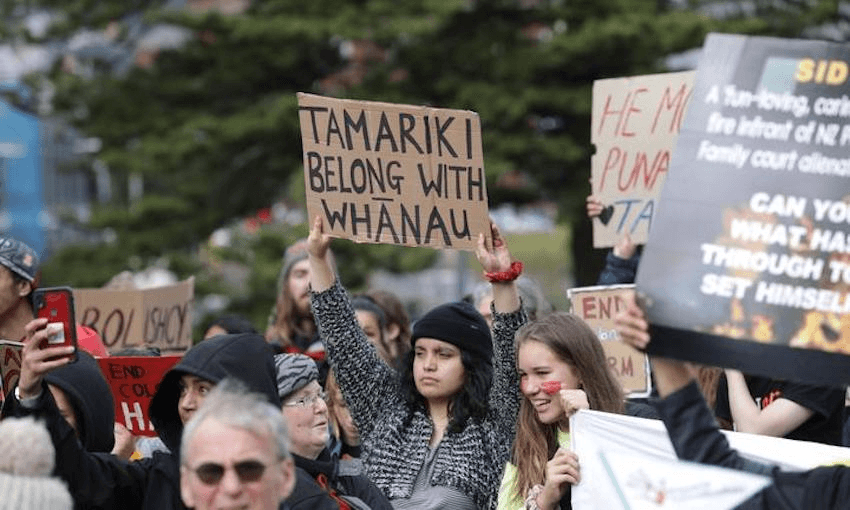The Waitangi Tribunal inquiry into Oranga Tamariki kicked off in Wellington last week, while at the same time the agency released new data showing that perhaps it is doing better for Māori than many perceive. But do the numbers tell the full story?
The first two days of the Waitangi Tribunal urgent inquiry into Oranga Tamariki took place last week. The contextual hearings now under way at the tribunal represent the latest milestone in the ongoing inquiries into Oranga Tamariki, following widespread protest from Māori in 2019. Over the next few months, the tribunal will consider whether the actions of Oranga Tamariki constitute a breach of Te Tiriti o Waitangi.
Witnesses gave evidence about the actions of Oranga Tamariki in both its present and past forms. Children’s commissioner Andrew Becroft spoke about the discriminatory treatment of Māori mothers highlighted by his organisation’s recent review of Oranga Tamariki. Tania Williams Blyth, a family lawyer and researcher widely respected throughout Māoridom, spoke to the enormous challenges faced by whānau Māori who have been through care and protection proceedings in the family court. Kahurangi Iritana Kawhiwhirangi spoke of the significant power imbalance that exists between Māori and the state. For those present at the hearings, the mood was heavy.
Just as the hearings were getting under way, Oranga Tamariki publicly released two reports discussing the disproportionate number of Māori in contact with the agency. The first report found that while tamariki Māori are indeed over-represented, the disproportionality reduces when other factors are accounted for (the report labels these “other socioeconomic and parent/child characteristics”). The second report found that while the overall numbers of tamariki Māori in state care remain high, the number of entries into care over the past 12 months has decreased. Both of these findings seem positive at first glance, but do the numbers provided by Oranga Tamariki tell the full story?
The statistics regarding entries into care were questioned by Len Cook, former government chief statistician, in his evidence to the tribunal. Cook stated that while the average rate of Māori children coming into care halved between 2001 and 2019, the length tamariki Māori were held in care increased by two and half times during that period. In other words, children may be coming in to care less frequently, but they are staying in care longer. Cook questioned the robustness of the data provided by Oranga Tamariki. He also stated that the release of such data would not achieve the underlying purpose of public accountability while broader questions about the perceived legitimacy of the agency went unanswered.
But even if the numbers provided by Oranga Tamariki painted an accurate picture, are they all that matters? If we ignore Len Cook’s criticism for a moment and take the numbers at face value, would we be satisfied? Or do we need to understand the individual stories of people in contact with the system to truly understand what is happening?
Some of the stories shared by whānau in contact with Oranga Tamariki since the Hawke’s Bay case was publicised last year are horrific. They include one mother having her child removed just moments after giving birth and another mother being pressured into having an abortion by a social worker, who told her that having the child would put her at risk of having her other children removed. Those stories are from just one of the four reviews of Oranga Tamariki conducted over the past year, and they were echoed frequently throughout the tribunal hearing last week. While the numbers are undoubtedly important, those stories seem to me to be what matters most. It doesn’t matter how you count people if you treat them like they don’t count.
What about the statement by Oranga Tamariki that the overrepresentation of tamariki Māori can be explained by other factors? All that really tells us is that the children in contact with the child protection system are already facing other major challenges. The “other characteristics” highlighted in the report mentioned earlier include parental income, socioeconomic decile, parental involvement with the justice system, school disengagement and mental health provider contact. As a nation, are we satisfied with a child protection system that inflicts further harm on Māori children who are disproportionately likely to be poor, disproportionately likely to be struggling at school and disproportionately likely to be facing mental health challenges? As one of the claimants in the hearing last week put it, societal disadvantage compounds. Is that compounding disadvantage really an excuse for Oranga Tamariki, or should it be a source of shame?
At the risk of stating the obvious, there is an institution responsible for addressing those other problems. It’s called the government, and Oranga Tamariki is a part of it, not separate from it. Throughout the hearing last week, multiple witnesses stated that the whānau most likely to impacted by the failings of Oranga Tamariki are those who have been failed by multiple government departments over multiple generations. The fact that the most marginalised New Zealanders are the ones most consistently failed by the state can no longer be accepted as an excuse. What will Oranga Tamariki have to say about that? The hearings resume later this week, so we will soon find out.
